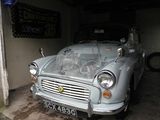Hi
does any one know if it makes a diference of what type of rubber spark plug caps i can buy for my car?
and does anyone know what the rubber caps on the ht lead that screws in to the dizzy is called and what gauge is the ht lead?
Thanks
Ben
Spark plug caps?
Forum rules
By using this site, you agree to our rules. Please see: Terms of Use
By using this site, you agree to our rules. Please see: Terms of Use
-
benwall101
- Minor Friendly
- Posts: 66
- Joined: Sun Feb 12, 2012 9:41 pm
- Location: Somerset
- MMOC Member: No
Re: Spark plug caps?
I don't know whether I've understood your questions, but it sounds as though you might be trying to replace your HT leads. Depending on what car you're talking about, and whether the coil and distributor cap have ever been replaced with, you could find one of three types of connection to your distributor cap: bakelite sleeve nuts on the HT leads, which have a split brass washer pushed over a short length of bared conductor; crimped-on ferrules on the HT leads which push into the cap and have plastic or rubber boots; or a small screw from inside the cap that pierces the insulation on the HT lead where it's pushed into the cap. The coil end will have one of the first two possibilities, but the boot, if fitted, is a different size.
HT lead comes in several outside diameters, but 7mm is the most common. It can either use copper conductors, or something that looks like black cotton, which has a high resistance and is designed to suppress radio interference, but can't be used with sleeve nuts. Plug caps come in unsuppressed or suppressed designs. You should not use suppressed caps with suppressed leads. Modern suppressed plug caps are often rubbish: the built in resistor either fails, or pings out and gets lost.
Crimping the connectors onto HT leads where these are required isn't easy to do neatly without a proper crimp tool, which isn't necessarily the one you've just splashed 30 quid on to do your Lucar or your bullet terminals.
Also be aware that with some plug caps you only get the rubber bit, not the brass bit inside: that's separate, and needs to be the right one for the HT lead you're using. Then there's straight or angled at the distributor end - straight ones can mean the HT lead fouls the steering column with some caps.
There's something to be said for just buying a made-up set, once you've identified the ends you need.
Kevin
HT lead comes in several outside diameters, but 7mm is the most common. It can either use copper conductors, or something that looks like black cotton, which has a high resistance and is designed to suppress radio interference, but can't be used with sleeve nuts. Plug caps come in unsuppressed or suppressed designs. You should not use suppressed caps with suppressed leads. Modern suppressed plug caps are often rubbish: the built in resistor either fails, or pings out and gets lost.
Crimping the connectors onto HT leads where these are required isn't easy to do neatly without a proper crimp tool, which isn't necessarily the one you've just splashed 30 quid on to do your Lucar or your bullet terminals.
Also be aware that with some plug caps you only get the rubber bit, not the brass bit inside: that's separate, and needs to be the right one for the HT lead you're using. Then there's straight or angled at the distributor end - straight ones can mean the HT lead fouls the steering column with some caps.
There's something to be said for just buying a made-up set, once you've identified the ends you need.
Kevin
